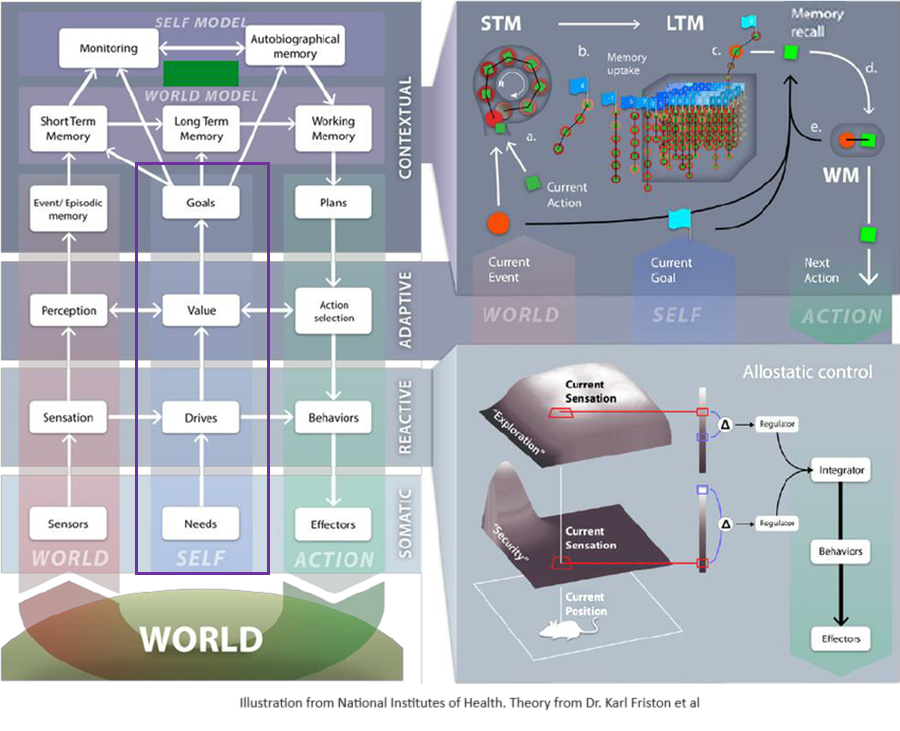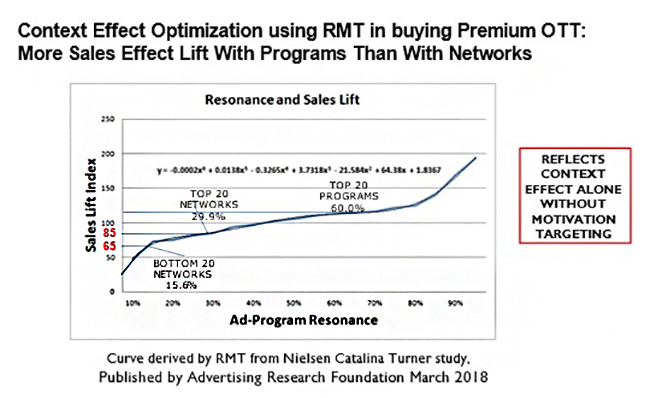Focus on Consumer Goals

What is the consumer trying to achieve? Why? How can our brand help?
The National Institutes of Health consider goal-driven behaviors to be the core of human psychology, as shown by the purple box I imposed on their schematic below.

Neuroeconomics Second Edition's main thrust centers around VS. VS stands for Value Signals. These are specific phenomena that can be measured in the brain, which are related to the computations of the inference engine as it regards to a decision to be made. Such as whether to consider buying a specific brand.
Dr. Karl Friston, the leading neuroscientist in understanding the brain’s inference engine, understands that the entire system is driven by specific goals of the individual.
The following words are all talking about the same set of phenomena: goals, values, desires, motivations, drivers, and need states.
In marketing, there is widespread use of product-specific motivations in segmenting and targeting audiences with messages specially crafted for them.
The blind spot is the more universal motivations which cause the product-specific motivations.
For example, toothpaste brands understand that there is a segment that sees toothpaste for decay prevention, another that sees it as a breath freshener, yet another that sees it as a tooth whitener. This superficial notion of the consumer is used in creative briefs to give inspiration to the copywriter.
Invisibly, beneath the analysis horizon, the most likely consumers to try your new toothpaste brand for the first time might be those whose motivations are, e.g., to live for today. If you knew that, you could of course write the most effective ad. But instead, not going ahead and discovering that deep layer of motivation, you satisfy yourself by focusing on a specific product benefit, the awareness of which has long since been saturated.
How can the industry get down into the deep universal motivations in order to create more compelling creative?
In Canada, Vividata is providing deep universal motivation data, calling it their Drivers.
This enables subscribers to the special study to gain deep insights into different strata of interest, which creative people find useful.
Full disclosure: I’m one of the founders of RMT, whose VS metatags have been validated seven times, including ARF Cognition Council, NCS, Neustar, Simmons, and Wharton Neuroscience. Although my interest in developing values-based metatags precedes current neuroscience. My lifetime of introspection into the way my own mind works led me to conclude that values are the prime mover of advertising effectiveness and of decision-making in general, decades before neuroscience got there.
Neuroeconomics Second Edition says that there are hundreds of different value signals (VS) that have been identified in the brain. RMT hypothesizes that its 265 DriverTags each corresponds to one of the identified brain VS signals.
We know that RMT’s VS proxies have predicted and explained sales/branding increases 7 out of 7 times. 2 of the 7 times were predicting the most advanced neuroscience correlates of sales increases, long-term memory encoding, approach, and synchrony.
At the ARF ATTENTION 2024 Conference, FOX Chief Research and Analytics Officer Mainak Mazumdar, Wharton Neuroscience Initiative Director Michael Platt and I discussed the use of these value signals as proxies for EEG, using EEG as a calibration panel for the value signal proxies so as to be able to cover every ad and content impression.
The advertising industry through the World Federation of Advertisers (WFA), the Association of National Advertisers (ANA), and many other industry associations has prioritized measuring the relative efficacy of different media-type environments. It is one of their top 5 priorities (source: CIMM International Conference July 9, 2024).
Ironically, this was one of my highest priorities for most of my career, since my first series of agency assignments all involved the pioneering of media optimizers, and I had concluded in my first days in the business that without relative media impact weights, media optimizers would simply select vehicles based on the lowest CPM (with some variation based on reach considerations).
In the past few years, driven largely by the universal realization that a TV impression and an impression made by an ad in a digital scrolling platform are probably not equal – and by the Media Rating Council’s (MRC’s) creation of the Viewability Standards – the industry has rallied around attention measurements as the way to get media impact scores.
However, attention cannot take you all the way there, because it is not a driving factor of success, it is a gating factor which can ensure failure. An absence of attention can say no to advertising success, but a propensity of attention cannot guarantee advertising effectiveness because the mechanism underlying the sales-causing effect of advertising is persuasion. Motivations can take you all the way there because motivations are the basis for persuasion. An ad can change your predisposition to buy a brand by changing the way you perceive the brand in such a way as to persuade the mind (often below the level of conscious awareness) that the brand may have the instrumentality to help you achieve your motivations.
In the near future, we may find out that the combination of motivation and attention yields even greater incremental sales than either attention or motivation alone. However, at the present moment, motivation has seven independent scientific validations that it increases sales caused by advertising, while the ARF Attention Study so far has shown almost no correlation between attention and sales effect. (This was based on the creative pretesting use case; the upcoming third wave of the study will focus on the media use case which is likely to show some positive correlation with sales effect, because the attentional differences between immersive engrossing television and streaming media contexts and the other main media contexts – scrolling feeds and user-generated videos – is rather extreme, as first pointed out by Karen Nelson-Field some years ago.)
The way that RMT VS are applied is to calculate a Resonance score between the ad and the person, and/or between the ad and the context. The higher the Resonance, the more likely the sales effect, the relationship being a sigmoid curve, as RMT deduced from the NCS study sponsored by Turner under the command of its head of research at the time, Howard Shimmel:

Because Wharton Neuroscience has now shown that there is a high correlation between RMT Resonance and the three key brain measures most predictive (and presumed causative) of incremental sales effects (long-term memory encoding, approach, and synchrony), RMT is officially changing the name “DriverTags” to “RMT VS” i.e. RMT Value Signals. This reflects the hypothesis that neuroscience will ultimately determine that there is a one-to-one relationship between the hundreds of unique VS measured in the brain, and the RMT VS. Logically there must be a subjective experience (“qualia” is the term used by neuroscience) corresponding to each VS, a feeling, such as competency, or pride, or confidence, etc. all of which are semantically related to specific motivations/values. The RMT taxonomy which was derived by AI and ML (Machine Learning) from program choices people make as measured by set top box data has three levels: 265 VS, which cluster into 86 Need States, which cluster into 15 Motivations. When we completed this work a few years ago it was eerie to see that the 15 Motivations we empirically derived from decades of work bear a startling resemblance to the 5 levels of Maslow’s Hierarchy of Needs.

Posted at MediaVillage through the Thought Leadership self-publishing platform.
Click the social buttons to share this story with colleagues and friends.
The opinions expressed here are the author's views and do not necessarily represent the views of MediaVillage.org/MyersBizNet.


